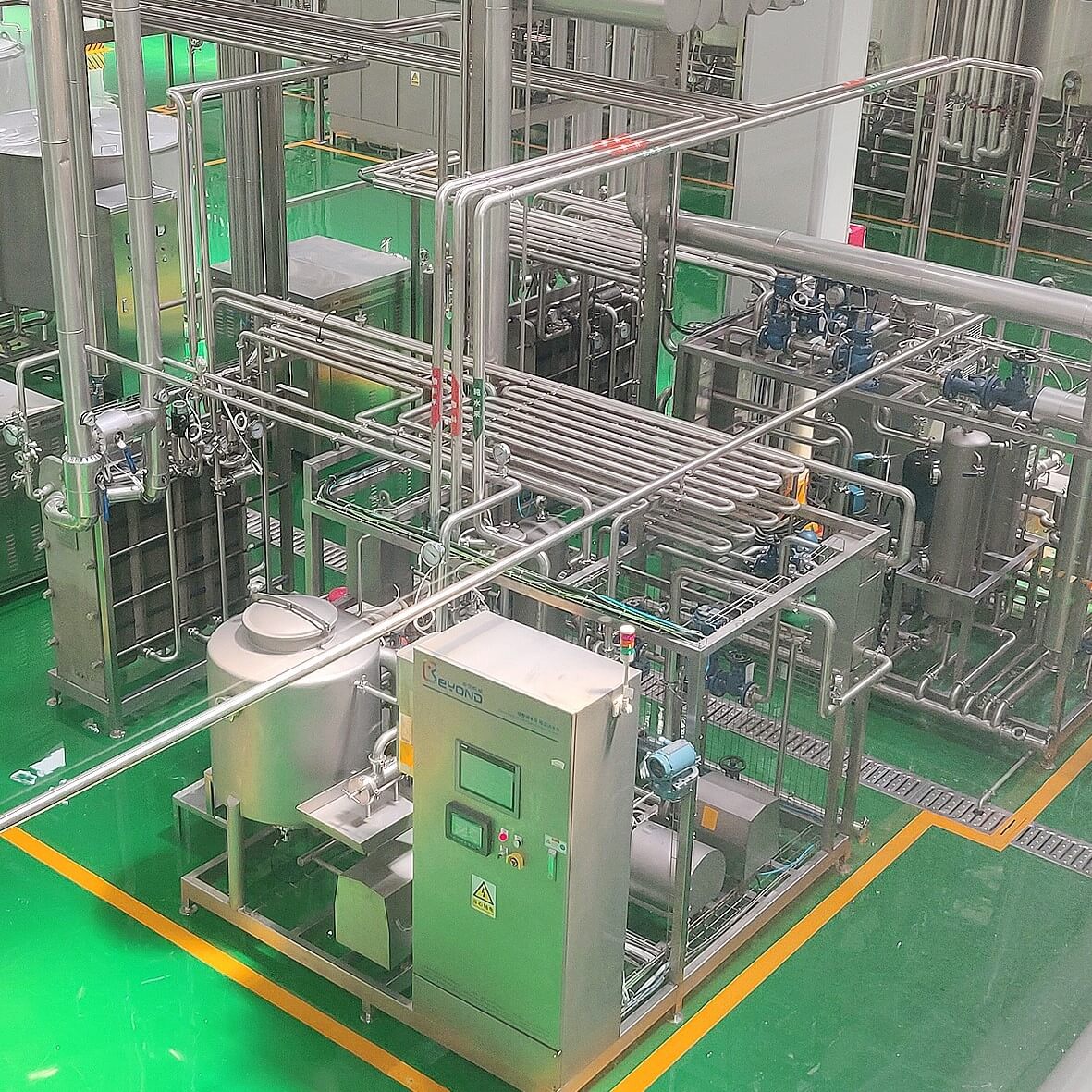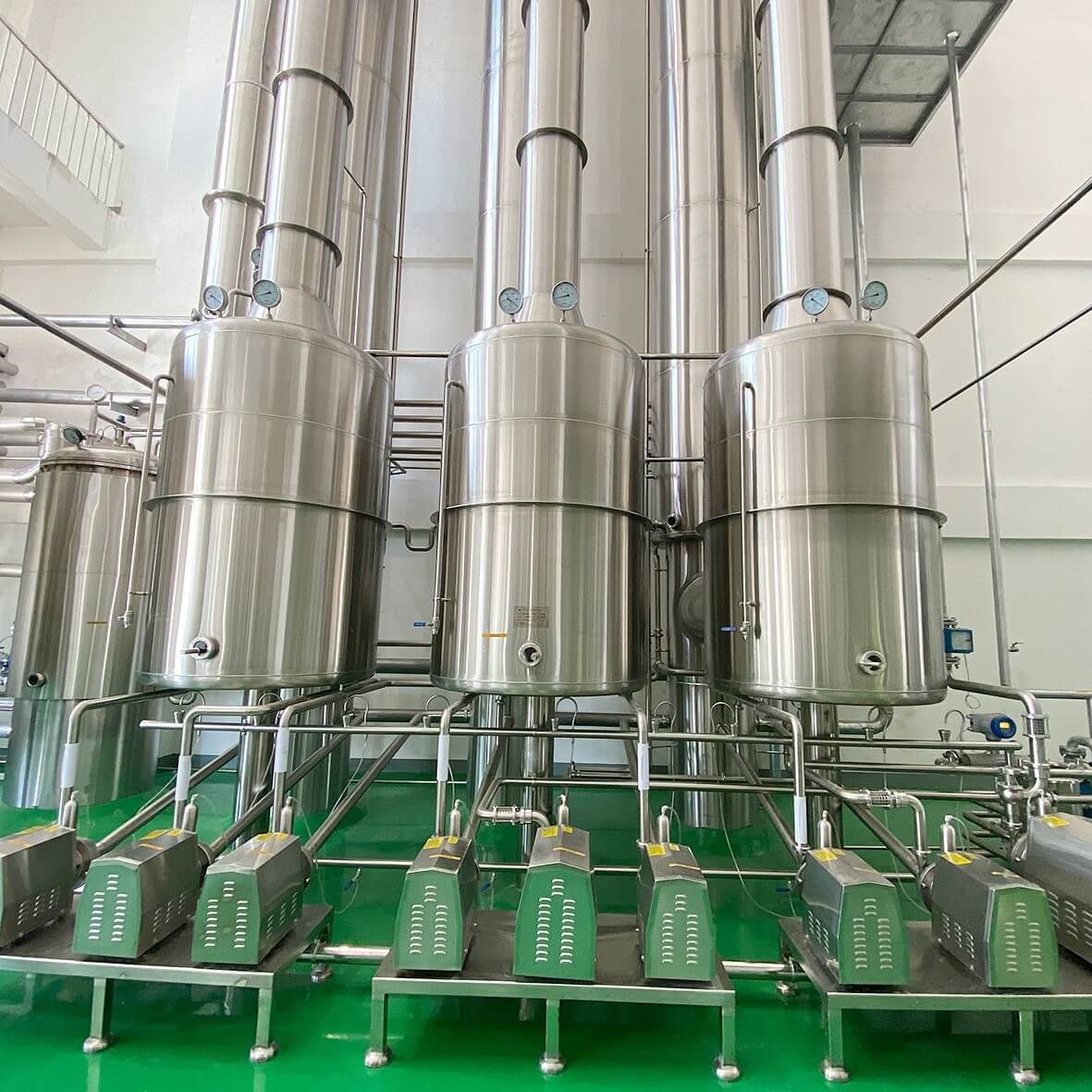
Maximizing Efficiency and Quality: Case Studies of Milk Processing Equipment
Dec 10, 2024
Milk processing equipment plays a crucial role in the dairy industry, covering the entire production process from receiving, storing, pre-processing, processing, packaging to finished products of raw milk. Here are some typical application cases of milk processing equipment:
1.1 Case Background
• Customer: A large dairy product company
• Product: Pasteurized milk
• Production capacity: 100 tons per day
1.2 Production Process
1. Raw milk reception: Receive fresh raw milk from the pasture.
2. Inspection: Conduct quality testing on raw milk to ensure compliance with standards.
3. Filtration: Remove impurities from raw milk.
4. Standardization: Adjust the fat content to meet product standards.
5. Homogenization: Refining fat particles and improving taste through a homogenizer.
6. Pasteurization: Use pasteurization equipment to sterilize milk at low temperatures for a long time, preserving its nutritional content.
7. Cooling: Quickly cool the sterilized milk to the appropriate temperature.
8. Filling: Fill the cooled milk into a packaging container.
9. Sealing: Seal the packaging container.
10. Packaging: Wrap the sealed product externally.
11. Storage and transportation: Store finished products in refrigerated warehouses and transport them to sales points.
1.3 Key equipment
Pasteurization equipment: used for low-temperature and long-term sterilization.
Homogenizer: used for homogenization treatment.
• Cooler: Used for rapid cooling.
Filling machine: used for filling.
Sealing machine: used for sealing packaging containers.
2. Ultra high temperature instantaneous sterilization equipment (UHT)
2.1 Case Background
• Customer: An internationally renowned dairy product brand
• Product: Long shelf life milk
• Production capacity: 200 tons per day
2.2 Production Process
1. Raw milk reception: Receive fresh raw milk from the pasture.
2. Inspection: Conduct quality testing on raw milk to ensure compliance with standards.
3. Filtration: Remove impurities from raw milk.
4. Standardization: Adjust the fat content to meet product standards.
5. Homogenization: Refining fat particles and improving taste through a homogenizer.
6. Ultra high temperature instantaneous sterilization: Use UHT equipment to sterilize milk at high temperature for a short period of time, ensuring that the product is stored at room temperature for a long time.
7. Cooling: Quickly cool the sterilized milk to the appropriate temperature.
8. Aseptic filling: Fill cooled milk into packaging containers in a sterile environment.
9. Sealing: Seal the packaging container.
10. Packaging: Wrap the sealed product externally.
11. Storage and transportation: Store finished products in a room temperature warehouse and transport them to sales points.
2.3 Key Equipment
UHT equipment: used for high-temperature short-term sterilization.
Homogenizer: used for homogenization treatment.
• Cooler: Used for rapid cooling.
Aseptic filling machine: used for aseptic filling.
Sealing machine: used for sealing packaging containers.
3.1 Case Background
• Customer: A local dairy company
• Product: Yogurt
• Production capacity: 50 tons per day
3.2 Production Process
1. Raw milk reception: Receive fresh raw milk from the pasture.
2. Inspection: Conduct quality testing on raw milk to ensure compliance with standards.
3. Filtration: Remove impurities from raw milk.
4. Standardization: Adjust the fat content to meet product standards.
5. Heating: Heat the raw milk to the appropriate fermentation temperature.
6. Vaccination: Add fermentation agents such as lactic acid bacteria.
7. Fermentation: Fermentation is carried out under constant temperature conditions.
8. Cooling: Cool the fermented yogurt to a suitable temperature.
9. Mixing: Mix the yogurt evenly.
10. Filling: Fill yogurt into packaging containers.
11. Sealing: Seal the packaging container.
12. Packaging: Wrap the sealed product externally.
13. Storage and transportation: Store finished products in refrigerated warehouses and transport them to sales points.
3.3 Key Equipment
Fermentation tank: used for fermentation.
Heater: used for heating.
• Cooler: Used for cooling.
Blender: used for mixing.
Filling machine: used for filling.
Sealing machine: used for sealing packaging containers.
4.1 Case Background
• Customer: A manufacturer of infant formula milk powder
• Product: Infant formula milk powder
• Production capacity: 30 tons per day
4.2 Production Process
1. Raw milk reception: Receive fresh raw milk from the pasture.
2. Inspection: Conduct quality testing on raw milk to ensure compliance with standards.
3. Filtration: Remove impurities from raw milk.
4. Standardization: Adjust the fat content to meet product standards.
5. Concentration: Concentrate the raw milk through an evaporator.
6. spray drying: dry the concentrated milk spray into powder.
7. Cooling: Cool the powder to a suitable temperature.
8. Mixing: Add nutrients such as vitamins and minerals.
9. Filling: Fill the mixed milk powder into a packaging container.
10. Sealing: Seal the packaging container.
11. Packaging: Wrap the sealed product externally.
12. Storage and transportation: Store finished products in a dry and ventilated warehouse and transport them to sales points.
4.3 Key equipment
Evaporator: used for concentration.
• spray drying tower: used for spray drying.
• Cooler: Used for cooling.
Blender: used for mixing nutritional components.
Filling machine: used for filling.
Sealing machine: used for sealing packaging containers.
Success factors
Equipment selection: Choose high-quality equipment that is suitable for production needs.
Process optimization: Continuously optimize the production process to improve production efficiency and product quality.
Quality control: A strict quality control system ensures product quality at every stage.
Environmental protection: Take measures to reduce wastewater and exhaust emissions and protect the environment.
Employee training: Regularly train employees to improve their operational skills and safety awareness.

1.1 Case Background
• Customer: A large dairy product company
• Product: Pasteurized milk
• Production capacity: 100 tons per day
1.2 Production Process
1. Raw milk reception: Receive fresh raw milk from the pasture.
2. Inspection: Conduct quality testing on raw milk to ensure compliance with standards.
3. Filtration: Remove impurities from raw milk.
4. Standardization: Adjust the fat content to meet product standards.
5. Homogenization: Refining fat particles and improving taste through a homogenizer.
6. Pasteurization: Use pasteurization equipment to sterilize milk at low temperatures for a long time, preserving its nutritional content.
7. Cooling: Quickly cool the sterilized milk to the appropriate temperature.
8. Filling: Fill the cooled milk into a packaging container.
9. Sealing: Seal the packaging container.
10. Packaging: Wrap the sealed product externally.
11. Storage and transportation: Store finished products in refrigerated warehouses and transport them to sales points.
1.3 Key equipment
Pasteurization equipment: used for low-temperature and long-term sterilization.
Homogenizer: used for homogenization treatment.
• Cooler: Used for rapid cooling.
Filling machine: used for filling.
Sealing machine: used for sealing packaging containers.
2. Ultra high temperature instantaneous sterilization equipment (UHT)
2.1 Case Background
• Customer: An internationally renowned dairy product brand
• Product: Long shelf life milk
• Production capacity: 200 tons per day
2.2 Production Process
1. Raw milk reception: Receive fresh raw milk from the pasture.
2. Inspection: Conduct quality testing on raw milk to ensure compliance with standards.
3. Filtration: Remove impurities from raw milk.
4. Standardization: Adjust the fat content to meet product standards.
5. Homogenization: Refining fat particles and improving taste through a homogenizer.
6. Ultra high temperature instantaneous sterilization: Use UHT equipment to sterilize milk at high temperature for a short period of time, ensuring that the product is stored at room temperature for a long time.
7. Cooling: Quickly cool the sterilized milk to the appropriate temperature.
8. Aseptic filling: Fill cooled milk into packaging containers in a sterile environment.
9. Sealing: Seal the packaging container.
10. Packaging: Wrap the sealed product externally.
11. Storage and transportation: Store finished products in a room temperature warehouse and transport them to sales points.
2.3 Key Equipment
UHT equipment: used for high-temperature short-term sterilization.
Homogenizer: used for homogenization treatment.
• Cooler: Used for rapid cooling.
Aseptic filling machine: used for aseptic filling.
Sealing machine: used for sealing packaging containers.

3.1 Case Background
• Customer: A local dairy company
• Product: Yogurt
• Production capacity: 50 tons per day
3.2 Production Process
1. Raw milk reception: Receive fresh raw milk from the pasture.
2. Inspection: Conduct quality testing on raw milk to ensure compliance with standards.
3. Filtration: Remove impurities from raw milk.
4. Standardization: Adjust the fat content to meet product standards.
5. Heating: Heat the raw milk to the appropriate fermentation temperature.
6. Vaccination: Add fermentation agents such as lactic acid bacteria.
7. Fermentation: Fermentation is carried out under constant temperature conditions.
8. Cooling: Cool the fermented yogurt to a suitable temperature.
9. Mixing: Mix the yogurt evenly.
10. Filling: Fill yogurt into packaging containers.
11. Sealing: Seal the packaging container.
12. Packaging: Wrap the sealed product externally.
13. Storage and transportation: Store finished products in refrigerated warehouses and transport them to sales points.
3.3 Key Equipment
Fermentation tank: used for fermentation.
Heater: used for heating.
• Cooler: Used for cooling.
Blender: used for mixing.
Filling machine: used for filling.
Sealing machine: used for sealing packaging containers.

4.1 Case Background
• Customer: A manufacturer of infant formula milk powder
• Product: Infant formula milk powder
• Production capacity: 30 tons per day
4.2 Production Process
1. Raw milk reception: Receive fresh raw milk from the pasture.
2. Inspection: Conduct quality testing on raw milk to ensure compliance with standards.
3. Filtration: Remove impurities from raw milk.
4. Standardization: Adjust the fat content to meet product standards.
5. Concentration: Concentrate the raw milk through an evaporator.
6. spray drying: dry the concentrated milk spray into powder.
7. Cooling: Cool the powder to a suitable temperature.
8. Mixing: Add nutrients such as vitamins and minerals.
9. Filling: Fill the mixed milk powder into a packaging container.
10. Sealing: Seal the packaging container.
11. Packaging: Wrap the sealed product externally.
12. Storage and transportation: Store finished products in a dry and ventilated warehouse and transport them to sales points.
4.3 Key equipment
Evaporator: used for concentration.
• spray drying tower: used for spray drying.
• Cooler: Used for cooling.
Blender: used for mixing nutritional components.
Filling machine: used for filling.
Sealing machine: used for sealing packaging containers.
Success factors
Equipment selection: Choose high-quality equipment that is suitable for production needs.
Process optimization: Continuously optimize the production process to improve production efficiency and product quality.
Quality control: A strict quality control system ensures product quality at every stage.
Environmental protection: Take measures to reduce wastewater and exhaust emissions and protect the environment.
Employee training: Regularly train employees to improve their operational skills and safety awareness.
I hope these application cases of milk processing equipment can provide you with reference and assistance. If you have more specific needs or questions, please feel free to let me know at any time!
Shanghai Beyond Machinery Co., Ltd.
Beyond Machinery specializes in the design and manufacturing of milk processing equipment.Please contact us now, and ourprofessional technical engineers will customize the equipment plan for milk processing equipment and provide a quotation.Please contact us now to obtain the latest equipment plan and quotation.
News
Hot Product



